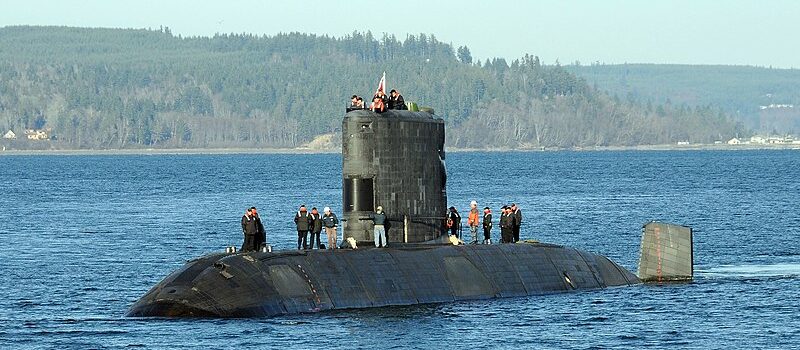Upholder, Unseen, Ursula, Unicorn
Cold War British Submersibles:
T class streamlined | Amphion class | Explorer class | X51 class | Porpoise class | Oberon class | Upholder classHMS Dreadnought | Valiant class | Churchill class | Swiftsure class | Trafalgar class | Resolution class | Vanguard class
The Upholder class submarines, also “Type 2400” due to their displacement, were the last class of diesel-electric submarines built for the Royal Navy, after the arrival of HMS Dreadnought in 1960. They succeeded to the Oberons, and were designed as a cheap alternative to supplement nuclear submarines in the Royal Navy.
The resurrected the WW2 “U class” by name and concentrate the best tech of the time, in a completely new hull compared to the Oberons, two decades older. They however had a short service life. Completed in 1990-93, they were paid off in 1994 and resold to Canada, in the new context of post-cold war budget restrictions. This came after unsuccessful bid to transfer these to the Pakistan. Modernized, they are still active in the Canadian Navy today as the Victoria class (future post). They initially suffered from serious electrical problems and operational incidents, later overcome until full operational capability.
The Upholder class submarines are a class of diesel-electric patrol submarines originally built for the Royal Navy of the United Kingdom in the late 1980s and early 1990s. Known for their quiet operation and effective armament, these submarines were intended to supplement the Royal Navy’s existing fleet by providing a smaller, more versatile submarine capable of coastal patrol and anti-submarine warfare (ASW). However, the Upholder class had a relatively short service life with the UK, as the Royal Navy transitioned to an all-nuclear submarine fleet, resulting in these submarines being sold to Canada in the late 1990s.
Displacement: ~2,400 tons surfaced, ~2,450 tons submerged
Length: 70.3 meters (230 feet)
Propulsion: Diesel-electric, powered by two Paxman Valenta 1600 RPS diesel engines driving an electric motor and a single shaft
Speed: Up to 20 knots submerged, 12 knots surfaced
Range: Approximately 8,000 nautical miles at 8 knots
Depth: Operational depth is estimated around 200-300 meters
Armament: Torpedoes: Equipped with six 21-inch torpedo tubes capable of launching Mark 48 torpedoes (after their Canadian modification) or other compatible torpedoes and anti-ship missiles.
Missiles: Able to carry Sub-Harpoon anti-ship missiles (primarily with the Canadian navy’s modifications).
Mines: Can be outfitted for mine-laying operations if required.
Royal Navy Service (1990–1994):
Four Upholder-class submarines were built: HMS Upholder, HMS Unseen, HMS Ursula, and HMS Unicorn.
Designed to operate in the North Atlantic, these submarines were quieter and smaller than nuclear-powered submarines, ideal for operations closer to shorelines.
However, they were phased out due to budget constraints and the Royal Navy’s shift to an all-nuclear fleet.
Canadian Navy Service (1998–Present):
The submarines were purchased by Canada, reclassified as the Victoria class, and underwent extensive refitting and upgrades to meet Canadian requirements.
Renamed as HMCS Victoria, HMCS Windsor, HMCS Corner Brook, and HMCS Chicoutimi.
Although they faced initial technical issues and refit delays, they have since been an essential part of the Royal Canadian Navy, providing crucial capabilities in coastal defense and ASW.
The Upholder/Victoria class submarines remain operational in the Royal Canadian Navy, where they contribute to Canada’s maritime security strategy, particularly in the Arctic and Atlantic regions.
Note: This is a starter to be completed in 2025.
⚙ specifications |
|
| Displacement | 2,455 t (2,416 long tons) |
| Dimensions | 70.26 x 7.2 x 7.6m (230 ft 6 in x 23 ft 7 in x 24 ft 11 in) |
| Propulsion | 1 shaft 2× Paxman Valenta 2,035 hp (1.517 MW) diesels, 1 GEC electric motor 5 MW |
| Speed | 12 knots (22 km/h; 14 mph) surfaced, 20 knots (37 km/h; 23 mph) submerged |
| Range | 8,000 nmi (15,000 km; 9,200 mi) at 8 kn, 10,000 nmi (19,000 km; 12,000 mi) snorkelling |
| Armament | 6 x 21 in (533 mm) torpedo tubes (18 Mark 48 torpedoes) |
| Test depth | 656.17 ft (200 m) |
| Sensors | CN/BQQ-10, Type 2040, 2041 micropuffs, 2007 flank, 2046/CANTASS MOD, 2019 active |
| Crew | 53 |
Career of the Upholder class
Career to come
Career to come
Career to come
Career to come
Read More/Src
Books
Links
https://en.wikipedia.org/wiki/Upholder/Victoria-class_submarine
